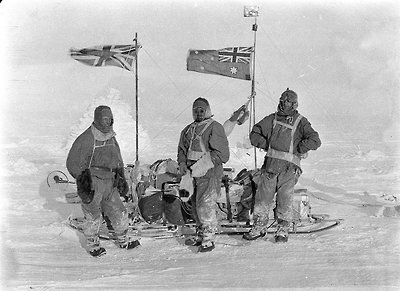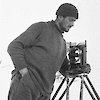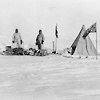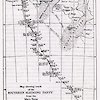Trudging to nowhere
Southern party departed Cape Denison 9 November 1912; farthest point 21 December 1912; returned 11 January 1912; distance travelled c 970 km.
‘I hate this icy plateau,’ wrote Laseron to his diary on 23 November 1912:
It gets on one’s nerves. Not only in bad weather, but even when beautifully fine it is tremendously oppressive. It’s too big, never-ending, day after day the same white expanse of utter absolute desperation and death. Nothing alive except ourselves and this even it somehow seems to resent. It is a great relief to get inside the tent and get some finality of vision.
He was one of the lucky ones: with Herbert Murphy and John Hunter, having laid a supply depot for the Southern party 108 kilometres out from Cape Denison, he was well on the way back to home comforts. Those he left behind on the plateau — Robert Bage, Eric Webb and Frank Hurley — were heading out into the great white unknown, with their only destination the invisible, intangible South Magnetic Pole — a ‘will o’ the wisp’, as Webb described it many years later.
Bage, Webb and Hurley knew theirs would be the most monotonous of the sledging journeys, across a featureless ice plateau where even the horizon disappeared in frequent white-out conditions. But while the temperature steadily dropped, they enjoyed one benefit denied to their fellow-travellers. Winds tend to decrease away from the Antarctic coast, until they disappear altogether in the permanent high-pressure system that prevails over the high plateau. No-one expressed the changed environment better than Hurley:
It seems as if even sound has become frozen. The absolute calm strikes our ears making them ring. Not a buzz of insect, not even the note of a song bird but a silence awesome and spacelike … Around reigns a silence stagnant that seems worse than even noise. Yet what a welcome change to us, that have been so wind battered.
There were no landmarks they could note for guidance home. A sledge meter told them the distance they had travelled, a sun compass gave them direction and astronomical observations confirmed their position. If it were not for the solid feel of ice under their feet they might have imagined themselves back aboard Aurora, with the giant Southern Ocean rollers transformed into an endless series of ice ridges.
Early signs were not promising. They measured their proximity to the South Magnetic Pole by the vertical, or ‘dip’, magnetic reading: the closer this was to 90 degrees the nearer they were to the pole. But far from steadily increasing, this remained steady at a maddening 49 minutes below 90 degrees.
Time was their other enemy. They had calculated they would need to travel 400 miles (644 kilometres) from Cape Denison to establish the pole’s location, but a snow storm early in December followed by heavy drift slowed their progress. With half their available time gone, the target was clearly impossible. They settled for 300 miles (483 kilometres), and reached it with a ‘tools and tent’ dash, ending with four hours of magnetic observations by Webb.
At their turning point, 1777 metres above sea level and 70 degrees 36.5 minutes South, their dip reading was a mere 16.7 minutes from the vertical, indicating they were less than 100 kilometres from their goal. But time had defeated them. They raised the Australian flag, gave three cheers for the King, and dashed back to their supplies to begin the long haul home.
Hurley was in charge of the Christmas Day cuisine. ‘Christmas pudding’ was sawn-up biscuits, pemmican fat, raisins, glucose and sugar boiled together in a hessian bag. ‘Wine’ consisted of stewed raisins and priming alcohol — ‘Hoyle 1912, a vintage very rare’ was how Webb later described it. (‘Hoyle’ was Hurley’s nickname, earned through his card-playing skills.)





